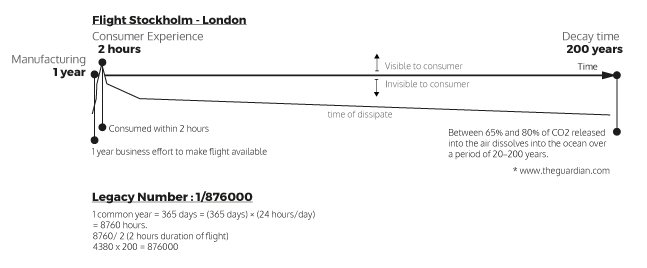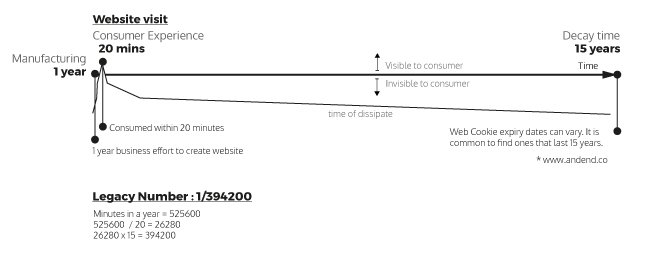Legacy Number - A consumer centric way to measure impact.
Measuring consumer impact is one of the most critical issues in the coming decade. Climate change has to become more tangible and actionable to the consumer. We can’t go on being good consumers by only buying “better” stuff. We have to get better, personal and meaningful data at the end and have visibility of the impact until its is neutralised.
There are three elements that I think undermine the consumer experience of measurement at the end of consumption.
Firstly, the units of measurement don’t stretch across different consumer sectors – carbon tonnage, megabytes of data, credit rating.
Secondly, the metrics used are sourced from either science, technology or legal language. Making it hard to visualise and quantify for the consumer – ‘what does a tonne of carbon look like?’
Thirdly, the way we measure improvement is by making “better” products – ‘this product took 2kg of carbon to make’. So the measurement stops at the point of purchase, yet it needs to measure to the point of neutralising.
Together these three issues stop the consumer gaining insights to their consumption or improving their behaviour.
What consumer measurement needs in the future is…
Measurement that has the consumer experience at its core.
Measurement that can be applied to a wide range of products – physical, digital, or service.
Measurement that looks forward to a point where the consumption has been neutralised.
Legacy Number
I have created this proposal to example improvement, and as a platform for further discussion.
The legacy number approach starts by using the duration of the consumers experience as the base unit of measurement. The consumer experiences this duration in tangible terms because they are immersed in it.
The next step is calculating the products neutralising point in the future. This helps the consumer see the ultimate exposure to impact in the future.
The next step is to calculate the multiples of experience to duration of impact.
Which finally provides a Legacy Number that represents the difference between the length of consumer experience and the length of decay.
Lets look at some examples.
Baked beans
For example, apply this to the act of consuming a tin of baked beans. Product experience duration is recommended at 3-4 days after opening if refrigerated. Product time to decay a tin in landfill is 50 years according to the California State government.
Dilute lemon
A glass bottle of dilute lemon would provide a different number from a can of beans. This products contents should be consumed within a month after opening. But the length of time for the glass to decay in landfill is almost infinite to a million years, it is like a rock in terms of decay according to GoingZeroWaste.com.
Flight
The model can stretch across different consumer engagements. For example, a flight between Stockholm and London takes two hours. As a result, lots of carbon dioxide is released into the atmosphere. According to The Guardian “...between 65% and 80% of CO2 released into the air dissolves into the ocean over a period of 20–200 years.” It takes up to 200 years for most of that to dissipate.
Web Cookies
The model can even be applied to digital experiences. Where a consumer might spend 20 minutes on a website, they might agree to cookies on that website that have an expiry date. These can vary greatly. In a recent article I wrote about the web cookie expired dates I found on some lasted thousands of years. These were rare, but it was common to find ones that had a duration of over 15 years.






